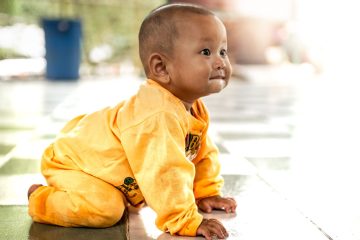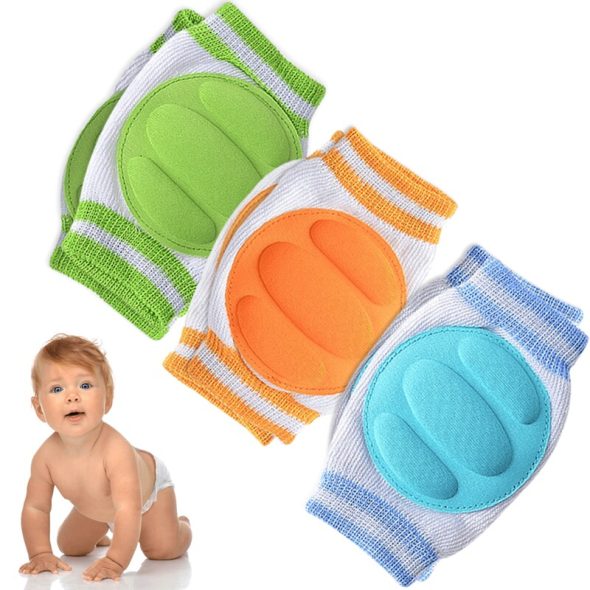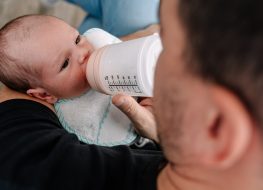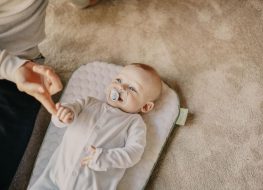
When a baby starts flailing its limbs, you know crawling will happen sooner than later. So they will want to use that energy and channel it into moving, be it forward, backward, or sideward.
Every one of us crawls before we walk, and when we crawl, we use a body part prone to injury—our knees. So if your knee region hurts when you kneel, even for just a few seconds, imagine that happening to your baby!
Let Ashtonbee discuss your concerns as a parent and help you keep your baby safe and comfortable during their crawling stage.
What Do I Need to Know About Crawling Babies?
As parents, we have plenty of questions revolving around the subject of crawling. But all of them stem from the four Ws. So let’s answer them all and help you understand your baby better.
When Do Babies Crawl?
Babies start crawling around 8 to 11 months old. By the time they reach their 12 to 14th month, they should be starting to walk. But this doesn’t happen instantly. In the months before the 8th, babies will make every attempt to do so. In some cases, they succeed and get to the crawling stage early because their parents helped them.
Why Do They Crawl, And Why Should You Let Them?
Crawling lets your little one develop their tummy, leg, and arm muscles. This increases their stability and improves their balance to the point where they can start taking their first steps.
What Style Do They Use When They Crawl?
It varies. But, when they crawl, the knee area is the most used and vulnerable body part. So, a 6-24 month baby should have a knee protector because the knee region takes the most hit when a baby crawls. As for style, we’ll discuss more techniques your little crawler does as they develop.
Where Can I Let My Baby Crawl?
It’s safer to crawl indoors, but risks are still involved whenever a baby explores any environment. So we recommend you baby-proof your house.
You can also manage where your baby walks to ensure their safety and protection. Apart from indoors, we’ll suggest other places where you can let your baby practice their little knees, which will help them crawl easily.
Different Crawling Styles of Babies
Your little crawler adopts different styles at every stage of your child’s development. Based on our observations with babies and feedback from parents, here are the following crawling style transitions your baby does.
Still Like a Seal
Technically speaking, this isn’t crawling, but it encourages your baby to attempt. The seal position happens when you place your baby on their tummy. The style allows them to move their arms and legs on the ground while they practice steadying their hands and raising their neck—like a seal fresh out of the water, taking a rest.
This is a style babies adopt during their early months. Particularly on a 1 – 8 months span.
Arm Crawl
They start using their forearms to crawl while their neck is raised. Their upper limbs and tummy become more developed as they grow, and they use it to drag their lower body across the hardwood floors-kind of like a soldier.
At this stage, your little crawler could use some protection against friction. Let them wear cotton leg warmers or crawling pants to protect the baby’s skin from irritation from the floor.
Hands and Knees Crawl (Normal Crawl)
This is the crawling style they adopt by the time they reach eight months up to 11 months or more. Your baby learns to use their little knees and hands to support their body weight while they move forward (or backward). This is known as the normal crawl.
At this stage, knee protection is important because the knee area takes all the impact and weight. So keep those baby knees protected with knee pads for crawling. You’ll know more about its benefits in the later section.
Feet, Knees, and Hands Crawl
Eventually, your baby will come to a point where they’ll attempt to use their feet as they crawl. This is a natural transition, as the impact of the knees on the ground can feel a bit painful, especially when they tend to stretch out their knees only to come back down on the ground.
They’ll start crawling by alternating their feet and their knees. They’re going to look like lizards crawling on all fours.
Feet and Hands Crawl (Bear Crawl)
Finally, they’ll start to crawl using their feet and hands once their leg muscles are strong enough, like a bear. In this stage, knee protection is still necessary, but only when they drop back to the ground.
This is the last milestone your little one will achieve before they attempt to take their first, hands-free footstep.

Baby’s Knee Pads: Your Little One’s Crawling Companion
In each crawling stage your baby goes through, they’ll mostly use their knees. It’s a good idea to get a knee pad as early as possible. Here’s what this protecting equipment can do for your baby.
Protects From Bruises, Scrapes, and Knee Impacts
Pounding and dragging their knees on the floor is bound to cause injury. Bruises, scrapes, and impacts are inevitable if they play on a hard surface.
Baby knee pads have protective cushions that prevent knee injury so your baby can keep crawling and developing.
Anti-slip
The anti-slip knee pad keeps your baby from falling flat on its tummy. It keeps them on their knees longer. So they’re more able to develop their leg muscles and crawl forward without interruption.
Ashtonbee Makes Safe and Comfortable Knee Pads for Crawling Babies
Safety and protection are necessary for your baby to develop well. That goes for everything, including when your baby crawls. Ashtonbee believes that the best baby knee pads for crawling bring safety and protection while keeping your baby comfortable. A comfy child is a happy child, and they will be at ease with the knee pad they wear, enough to wear it until they start walking.
You can explore our website if you want to check out Ashtonbee’s knee pads. If you’re looking for other items, you can check out our collection of baby essentials here.



